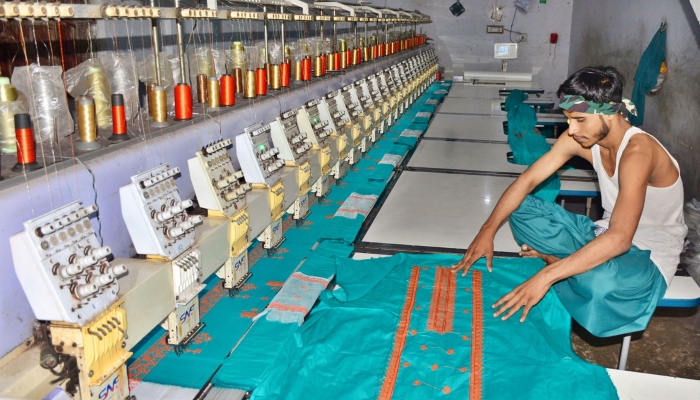Can Pakistan emerge as textile sourcing hub amid BD turmoil?


ISLAMABAD: Bangladesh, which has increased its exports to $47 billion per annum, is in massive political and economic turmoil.
Many multi-national companies are in the process of shifting their sourcing operations away from Bangladesh to mitigate risks.
This provides a unique opportunity for Pakistan to step in as an alternative sourcing hub, keeping in view its established textile industry and strategic location. Moreover, increasing exports is crucial for Pakistan to address its foreign exchange shortage, which is expected to exceed $25 billion annually for the next five years.
Pakistan has a long history of textile and garment production, with well-developed infrastructure, skilled labour, and a reputation for high quality and environmental sustainability.
Facts are that Pakistan has access to major markets in Europe, North America, and the Middle East and it can enhance its attractiveness as a potential alternative to Bangladesh. In FY22, Pakistan’s textile exports reached nearly $20 billion, signaling strong potential in the sector.
However, by FY24, exports plummeted to $16.7 billion due to prohibitive increases in energy prices, withdrawal of zero-rating and overall economic deterioration. The withdrawal of zero-rating (SRO 1125) was a significant blow to the industry as it squeezed all liquidity out of the market, leaving manufacturers struggling to maintain operations.
Now, with global shifts in sourcing, Pakistan has a renewed opportunity to boost its value-added apparel exports. However, realising this potential requires immediate and targeted reforms.
If the decision-makers in the country make sure regionally competitive energy tariff at 9 cents per unit electricity supply and $9 per MMBTU gas supply, Pakistan’s textile industry will regain its viability, compete effectively on the global stage and capture garment sourcing shifting away from Bangladesh but several reforms are essential. There are reports that the task force on the power sector is vigorously working out a strategy under which the industrial tariff would be reduced to a reasonable level apart from scaling down the electricity tariff for other consumer categories.
In addition, the taxation regime for domestic supply chain needs to be aligned with that of the import supply chain to create a level playing field. And, more importantly, zero rating (SRO 1125) for the entire textile value chain must be restored. And interest rates should be reduced to single digits to ease the liquidity crisis and encourage higher production and investment. However, some economists say that there are chances that at the end of the current calendar year, interest rate may come down to 12-13%. And finally, the government top notches need to increase their focus on hiking cotton production to a minimum of 15 million bales annually at sustainable basis.
Pakistan’s textile industry faces a series of significant challenges that hinder its ability to capitalise on the shifting global garment sourcing dynamics. A major obstacle is the prohibitive cost of energy. Industrial power tariffs in Pakistan are upwards of 15 cents/kWh, which is almost double the 8.3 cents/kWh in Bangladesh. Moreover, while Bangladesh’s industry benefits from cheap gas at $7.4/MMBtu, industry in Pakistan is being supplied with an RLNG/gas blend at $13/MMBtu.
Labour costs also contribute to the financial strain on Pakistan’s textile sector. The minimum wage for garment workers in Bangladesh is $113 a month, whereas in Pakistan, it stands at $135, a difference of approximately 20%. This wage gap, coupled with higher energy costs, further erodes Pakistan’s competitiveness.
In addition to these cost disparities, Bangladesh offers a range of incentives that make it an attractive destination for garment manufacturing. These include exemptions from income tax for 50% of export earnings, preferential income tax rates of 10-12% for Ready-Made Garment (RMG) factories and a reduced withholding tax on export earnings at just 0.5%.
New firms in Bangladesh can also benefit from phased or partial tax exemptions for five to 10 years, along with financial support mechanisms like a 15% cash credit for pre-shipment expenses, packing credit for CIF expenses, post-shipment finance covering 50-80% of L/C value and long-term USD financing at a maximum rate of 8.5%.
In contrast, Pakistani exporters are burdened with a 2% advance tax and a final income tax rate of 29%. The withdrawal of zero-rating (SRO 1125) dealt a significant blow to the domestic industry, and more recently, the sales tax exemption on local supplies for export manufacturing was also rescinded.
The negative impact of these policy changes is further compounded by persistent and indefinite delays in sales tax refunds. Coupled with tight monetary policy and high interest rates, this has resulted in an industry-wide liquidity crisis and shortage of working capital. Interest rates in Bangladesh are substantially lower at 8.5% compared to 19.5% in Pakistan, further tilting the playing field in Bangladesh’s favour.
Originally published in The News
Source link



